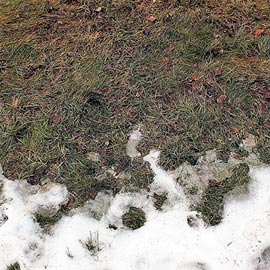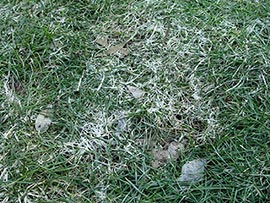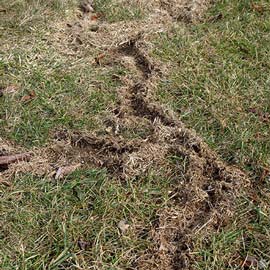Winter’s relentless cold, ice and snow cover can be taxing for lawns throughout the U.S. If you're one of those areas unaffected by harsh winter weather - keep smiling! With spring just around the corner and warmer temperatures on the horizon, it's a great time to consider these five tips to get your lawn off to a good start:
 A long, cold, snow-covered winter can lead to a slow lawn start in spring.
A long, cold, snow-covered winter can lead to a slow lawn start in spring.
pavelalexeev / iStock / Thinkstock
1. Clear the way. If the melting snow revealed fallen twigs, mats of brown leaves or other debris on the lawn, rake it off. Anything that might impede new growth or block sunlight to the blades needs to go. But don’t be too quick with the rake. Wait until the ground dries and warms a bit. Walking on cold, soggy soil can squish out tiny air pockets and compact the soil. That’s bad news for grass-root growth.
 Snow mold is an early-spring lawn fungal disease that usually corrects itself.
Snow mold is an early-spring lawn fungal disease that usually corrects itself.
George Weigel
2. Check for disease. Fungal lawn diseases known as “snow mold” are common in early-spring lawns, especially in years with late-to-melt snow covers. These look like dead patches in the lawn with flattened blades and either a gray or pink cast. The good news is that otherwise healthy lawns usually recover and push new growth once warmer, drier weather moves in. Fungicides are seldom needed or recommended. Just rake off dead blades once the soil is no longer soggy and watch for new shoots.
 Voles make surface tunnels in the lawn under winter snow cover.
Voles make surface tunnels in the lawn under winter snow cover.
George Weigel
3. Check for vole tunnels. Voles are mouse-like rodents that feed on plant roots, seeds, tender bark and bulbs. In the winter, they often venture out into the lawn because predator birds can’t find them under snow cover. Unlike moles, which make raised ridges and occasional soil “volcanoes” in the lawn, voles make shallow, curving tunnels in the lawn surface. They go back into hiding under bushes in spring, but the tunneling damage they leave behind should be raked off in early spring. Grass often fills back in, but you can speed up the process by sprinkling GreenView Fairway Formula Grass Seed and GreenView Fairway Formula Seeding Success in the tunnels.
4. Fertilize. Spring is one of two prime times to fertilize the lawn (the other being early fall). A spring dose of nitrogen supplies grass with the nutrients it needs heading into its fastest-growth time. Choose a product with slow-release nitrogen for nice even, slow greening such as GreenView with GreenSmart Lawn Food or GreenView Fairway Formula Lawn Fertilizer and it will last between 3 and 4 months. If you haven’t tested your soil in a few years, early spring is a good time to do that to get a more exact reading on specific nutrient needs such as whether any lime or sulfur is needed to alter the soil pH (its acidity level).
5. Head off the crabgrass. A common “junk grass” called crabgrass is much easier to prevent than to control once it has sprouted. This low, creeping grass begins germinating from last year’s fallen seed once the soil temperature reaches about 55 degrees, so yes - you need to be concerned about it every year, especially if your neighbor isn't. A good indicator of when to watch for crabgrass is when forsythia bushes have reached peak bloom. Granular crabgrass preventers can be applied at this point to head off an outbreak of new crabgrass and some even have post-emergent effectiveness that will kill the crabgrass up to 4 weeks after it emerges. Check out GreenView Fairway Formula Spring Fertilizer with Crabgrass Preventer.